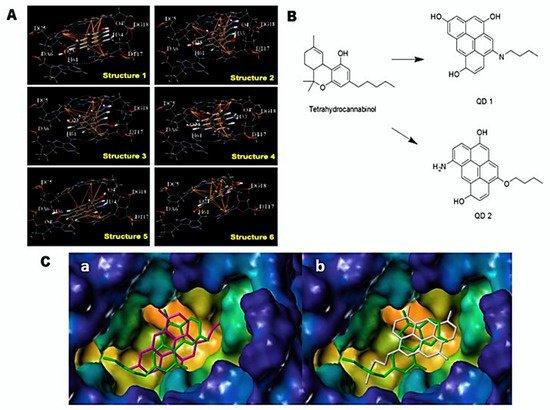UTEP researchers help bring biofriendly materials to drug design for neuro disorders

The contributions of researchers from The University of Texas at El Paso have yielded the first indication that carbon quantum dots, a class of nanoparticles, can be utilized to combat neurological disorders. Credit: Mahesh Narayan
The study, titled “Untangling the Potential of Carbon Quantum Dots in Neurodegenerative Disease,” was co-authored by Sreeprasad T. Sreenivasan, Ph.D., and Mahesh Narayan, Ph.D., assistant professor and professor, respectively, in UTEP's Department of Chemistry and Biochemistry.
The pair contributed to work by Prakash Narayan, Ph.D., vice president of preclinical research for Angion Biomedica Corp. in Uniondale, New York; and Lindsey Jung, a student at Tenafly High School in New Jersey, who works under Prakash Narayan's supervision.
The study focuses on carbon quantum dots (CQDs), biofriendly materials synthesized from waste materials such as wood, fruit peel, algae and even salmon.
A road map laid out by the research team addresses, for the first time, key requirements for the transitioning of their use from environmental-sensing applications into the neurodegenerative domain; a crossing-over that requires their separation and total characterization, including aspects related to safety and their ability to target specific receptors in the brain.
“The carbonaceous quanta are finally making their way from physics into chemistry and now, biology,” Prakash Narayan said. “This work lays the foundation for harnessing the enormous potential of carbon quantum dots for therapeutic intervention in neuro disease.”
The CQDs are made by “pressure-cooking” waste biomaterials such as fruit peel, amino acids, algae and even fish. As an outcome of the procedure, they are synthesized as a mixture of carbon dots and non-carbon dots. Some of the compounds in the mixture can be toxic. This aspect would negate their use in biomedical applications.
To facilitate the crossing-over of CQDs into preclinical and eventually clinical use, the research team provides a path for their safe use while demonstrating their potential to both prevent and treat neurodegenerative disorders, Mahesh Narayan said.
The research was conducted at Angion Biomedica, and at UTEP's Functional Quantum Materials Laboratory and the Laboratory for Neurodegenerative Research.
The transitioning of CQD applications from electrochemistry, catalysis and environmental sensing to biomedicine represents an important milestone in its 15-year history; a bellwether for its yet-unrealized potential in interventional biology, imaging, diagnostics, prophylaxis and therapy.
“This will allow pharmaceutical companies to tailor carbon quantum dots for specific uses,” Mahesh Narayan said. “Individuals with Parkinson's and Alzheimer's could benefit greatly from this kind of therapy.”
###
To read the full paper, visit https:/
Media Contact
All latest news from the category: Life Sciences and Chemistry
Articles and reports from the Life Sciences and chemistry area deal with applied and basic research into modern biology, chemistry and human medicine.
Valuable information can be found on a range of life sciences fields including bacteriology, biochemistry, bionics, bioinformatics, biophysics, biotechnology, genetics, geobotany, human biology, marine biology, microbiology, molecular biology, cellular biology, zoology, bioinorganic chemistry, microchemistry and environmental chemistry.
Newest articles

First-of-its-kind study uses remote sensing to monitor plastic debris in rivers and lakes
Remote sensing creates a cost-effective solution to monitoring plastic pollution. A first-of-its-kind study from researchers at the University of Minnesota Twin Cities shows how remote sensing can help monitor and…

Laser-based artificial neuron mimics nerve cell functions at lightning speed
With a processing speed a billion times faster than nature, chip-based laser neuron could help advance AI tasks such as pattern recognition and sequence prediction. Researchers have developed a laser-based…

Optimising the processing of plastic waste
Just one look in the yellow bin reveals a colourful jumble of different types of plastic. However, the purer and more uniform plastic waste is, the easier it is to…



